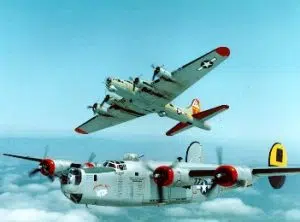Wayne Norman and Aaron Kupec fly on a World War II B-17 in October 1999
Written by Wayne Norman
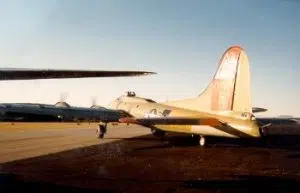
The B-17 “Flying Fortress” on the tarmac at Windham Airport
WAYNE and AARON‘s B-17 FLIGHT October 7, 1999
Last year it was a B-24. This year it was a B-17 “Flying Fortress.” Both planes came to Windham Airport last year as part of a nationwide tour from the Collings Foundation, and they invite media members on the flights for the obvious PR value. Non-media types paid $350 for this 30-35 minute thrill. And many do. Our B-17 flight had the full compliment of 8 passengers, and it was the second run of the evening.
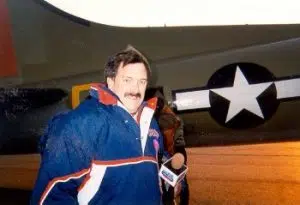
The experience was similar to the B-24 flight from a year ago. But while last year’s big thrill was being able to hang out the side of the B-24 thru an open 3′ x 5′ portal where the machine gun (side-gunner) operates, the B-17 had an open 3′ x 5′ portal in the roof. In each case you could get a mouthful of air at 170mph, while getting an incredible view from outside the aircraft.
And while last year I spent most of my time in and around that side portal in the center of the B-24’s fuselage, this year, I shimmied across the 8″ catwalk with rope rails to the flight deck, then negotiated some tight fits to go UNDER the flight deck to reach the nose gunner position. It’s just a plexiglass bubble on the nose of the plane (called a “blister”). From there, I had an incredible view ahead, up, down, and even back. I could look behind and see all four prop engines. And of course there are two machine guns pointing ahead also.
Then back to the open portal again. It was hard to keep my eyes open while looking straight ahead. And anything held up over the top of the plane (camera, microphone) almost got blown away. I taped a running play by play of the experience again, and knowing the outcome, I explained “I’m going to hold the mic into the wind now–you will probably hear a lot of “garbage.'” And the mic didn’t disappoint on playback. That wind screen isn’t made for something like THAT!

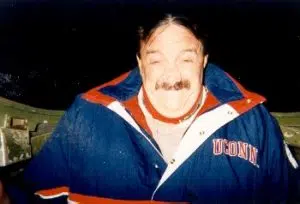
The side gunner position in this B-17 had plexiglass windows, unlike the open side of the B-24. This plane–the B-17G–was built in July 1943, and in this model, they staggered the right and left side gunners so they had more range to move their artillery (Browning Machine Guns). Their website has an exact history of the B-24 l, (mostly Pacific) and beyond (RAF and India had it post-war). This actual B-17 plane flew 140 missions in WWII–primarily Berlin. It had an interesting post-war history, including two cases where it looked like it would never fly again. One of the crew members gave these tidbits in the pre-briefing. …
+ The ladder inside is identical to the one Gregory Peck did chin-ups on in “12:00 High”
+ Post-war, this aircraft was sent out to Yucca Flats, NM and survived three Atomic Bomb tests. They wanted to see how it held up. It had a 13-year “cooling down” period (radiation), then was declared “safe.”
+ In the 70s it was based in Arizona where it was used for aerial borate bombing to contain forest/brush fires.
+ It was auctioned off in 1984 (dunno if that’s when The Collings Foundation got it).
+ The B-17 was the aircraft featured in the good 1990 movie “Memphis Belle” with Harry Connick, Jr., Matthew Modine, Eric Stoltz, and (Titanic star) Billy Zane. A website, (imdb) says there are a lot of factual errors in that film.
+ The crew member said, “looking out that top turret is like riding in a 170mph convertible. Anything not attached is gone.”
+ They tour 145 cities in 48 states and are on the road 10.5 months each year.
+ The Collings Foundation based in Stow, Mass., is a non-profit organization dedicated to restoring and flying these vintage aircraft. The planes rarely see Stow. Most repairs are done on site. The $350 flight fee essentially pays expenses and fuel.
+ Most of the passengers were older men–some of whom had either been in WWII, flew in WWII, or at least were alive then (I wasn’t).
+ Besides the original artillery (0.50″ machine guns) from each “blister,” this B-17 also carried 3 bombs, which were about 3 feet long and 1 foot across.
My photos were taken with a disposable flash camera, and it was twilight. We were the second of the two evening runs, and it was pretty dark by the time we returned.
Weather was similar to last year–50’s, but it was clear. I dressed pretty warm, and never felt the urge to take a layer off. Fall foliage wasn’t quite as colorful as last year, but we flew south, where it changes later. What little we saw was yellows and light greens.
We sat on the metal floor of the fuselage for takeoff and landing, on cushions (no seats) and a larger cushion for the back. Last year’s B-24 seatbelts were crude, but effective. These B-17G seat belts were like most commonly used now. Shortly after takeoff we were told we could move about freely.
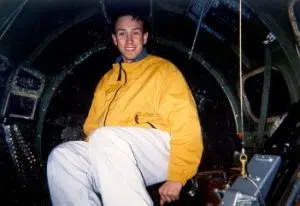 The B-17 is a lighter, more agile aircraft, and got off the ground quickly. Looking out the left side portal, I could easily see the Eastbrook Mall, Windham High, Main Street and the WILI building, The Windham Mills, Rec Park (the hardball field lights were on–probably for midget FB practice), the WILI-AM tower, later the WILI-FM tower in Lebanon, as we flew southbound at about 1000 feet. Around Norwich we did a complete 360, and continued down the Thames River to New London. You could see Old Saybrook (where the Ct. River meets LI Sound), Long Island, Fishers Island, and later Block Island as we went eastbound along the shoreline to about Mystic before circling north again. Foxwoods was a distinctive landmark–it just shoots up amongst the nearby trees. Back over Norwich and final descent into Windham Airport. Landing was noisier, but smoother than many commercial flights I have taken.
The B-17 is a lighter, more agile aircraft, and got off the ground quickly. Looking out the left side portal, I could easily see the Eastbrook Mall, Windham High, Main Street and the WILI building, The Windham Mills, Rec Park (the hardball field lights were on–probably for midget FB practice), the WILI-AM tower, later the WILI-FM tower in Lebanon, as we flew southbound at about 1000 feet. Around Norwich we did a complete 360, and continued down the Thames River to New London. You could see Old Saybrook (where the Ct. River meets LI Sound), Long Island, Fishers Island, and later Block Island as we went eastbound along the shoreline to about Mystic before circling north again. Foxwoods was a distinctive landmark–it just shoots up amongst the nearby trees. Back over Norwich and final descent into Windham Airport. Landing was noisier, but smoother than many commercial flights I have taken.
The appeal of these aircraft is apparent. The crowds weren’t as big this year as last year (perhaps because many had seen them last year, also because last year we went up on the first day–this year we went up on their second of three days). But there were a lot of people outside the tarmac fence watching these historical birds.
And after my recent moving experiences at Normandy, this was even more special because of the role these aircraft played in WWII. And as I sat at my computer Friday afternoon, I heard the B-24 leaving Windham Airport (couldn’t see it), and a few minutes later, the B-17 flew right over my house on the sunny day. I wish I had my camera then!
I got about 45 minutes of tape–crew briefing, then a running play by play in the air, which all aired the following morning on WILI. Several listeners later commented on how much they enjoyed it.

 The newspapers did a good job on this also. The Willimantic Chronicle got a terrific color photo of the B-24 landing at Windham Airport. And the Hartford Courant got a shot Friday from that same B-17 top turret portal, with the B-24 in view:
The newspapers did a good job on this also. The Willimantic Chronicle got a terrific color photo of the B-24 landing at Windham Airport. And the Hartford Courant got a shot Friday from that same B-17 top turret portal, with the B-24 in view:
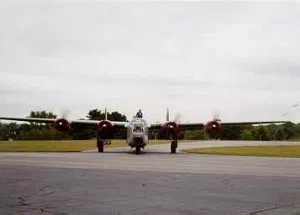 The actual printed version of this photo looked better (brighter) than the web photo.
The actual printed version of this photo looked better (brighter) than the web photo.
The Chronicle did a good story on Friday:
Pilot flies historic plane for hobby
By GAIL ELLEN DALY
WINDHAM — Some commercial airline pilots fish on their days off, Steve McDevitt recreates World War II.
In his “day job,” McDevitt is a pilot for Continental Airlines. During his downtime, the Mashpee, Mass., resident pilots a B-17 Flying Fortress.
“My father was a pilot during the Second World War,” McDevitt said Thursday, as he grabbed a long stick with which to measure fuel in the tanks. “I want to educate the next generation; give them what my father gave to me.”
The plane, which flew 140 missions during the war, is one of two totally restored aircraft owned and operated by the Collings Foundation of Stow, Mass.
The B-17 and a B-24 called “The Dragon and its Tail,” have been at Windham Airport since Wednesday afternoon and will be on display until this afternoon, bringing living history to area residents.
“These are not anything like modern planes,” McDevitt explained, pointing to the cables, outer metal skin and 5 horsepower auxiliary power unit that sits near the tail section. “It’s a classic, like a ’55 Chevy, rather than a modern Lexus.”
The plane has no heat, no bathroom, no fuel gauge and no real seats — only positions for the gunners.
“We’ve recreated everything, right down to the portable oxygen bottles,” he said.
McDevitt flew the old DC3s for Providence Boston Airlines, which made it easier for him to qualify on both planes. “These planes were designed to be flown by 20-year-olds with about 200 hours of air time,” he said.
Ed Fraher knows from experience about the young crews the planes carried. At the age of 18, the Manchester resident was a ball turret gunner on a B-24, flying missions over Germany and France. After 25 missions the plane remained intact, but Fraher recalls the flak that left bullet holes in its skin and the fear during takeoffs, the plane loaded with bombs and fuel.
“I felt immortal, thought nothing could hurt me,” he said, gazing at a B-24 for the first time in many years. “But I was sure scared the day we landed without any hydraulics.”
Bill Bacon did not fly in either of the planes. The Windham resident said he trained as a Navy fighter pilot during World War II, but the aircraft type was discontinued and he transferred to a carrier.
Eastford resident Jody Sanga only remembers the war from books and movies, but he worked with a man who was a gunner on the B-24. “He talked about the mission a lot — I can’t even imagine it, it’s unbelievable.”
“Unbelievable” was the reaction of virtually the entire crowd that gathered around the two craft. As the afternoon wore on, the crowd grew.
Although organizer Cherrie Danks of Windham Airport wrote to 14 area schools about the visit, she did not receive one single reply. “I told them about the nose art that might be considered obscene or offensive,” she said, “but to not get one reply is amazing.”
When the planes leave Windham this afternoon they will fly to Brainard Airport in Hartford where they will be on display all weekend.
And if they return next year? “We now have an F-4 Phantom from the Vietnam War,” McDevitt said. “But no one gets a ride.”
